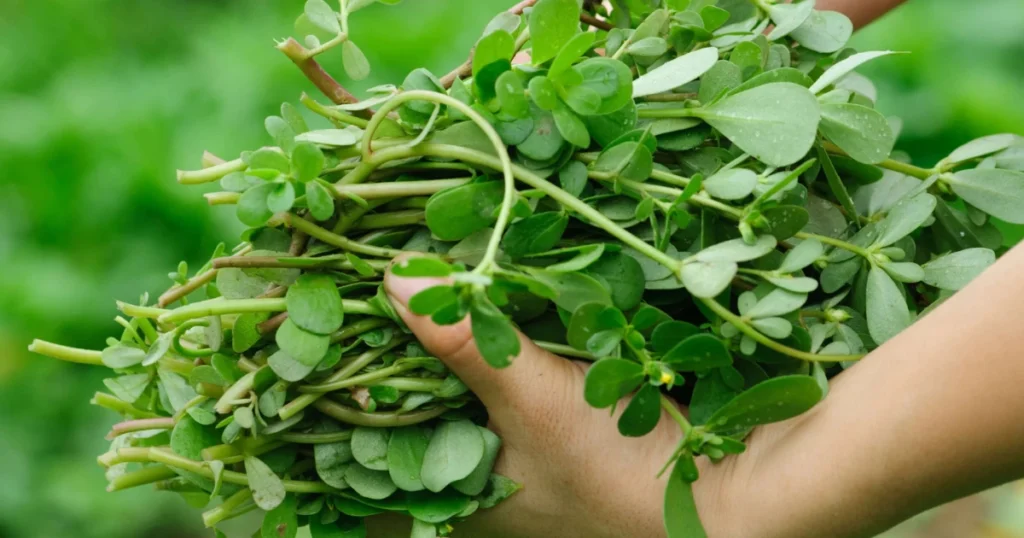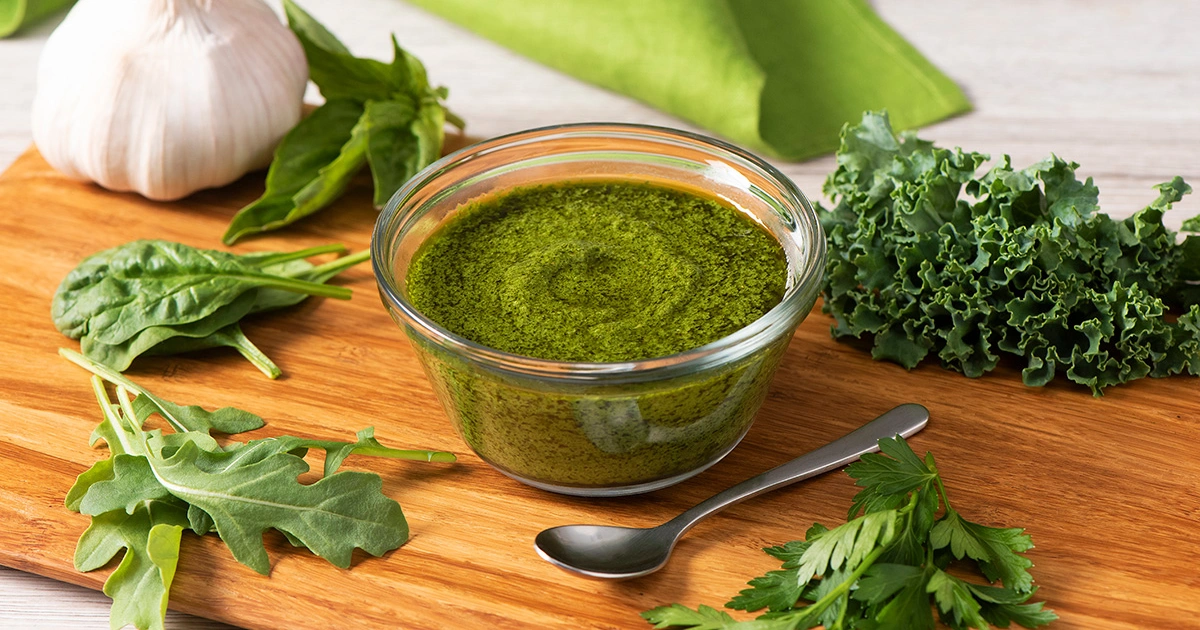You might be weeding it out of your garden without a second thought, but that green, low-growing succulent may be the most nutritious plant in your yard. Meet purslane—a crunchy, lemony, wild supergreen that’s often dismissed as a weed, but it’s packed with omega-3s, vitamins, and minerals.
Instead of throwing it away, you can turn it into a delicious, freezer-friendly pesto that’s ready to boost your meals with flavor and nutrition. In this guide, you’ll discover everything about purslane—how to identify it, why it’s healthy, and how to preserve it as convenient pesto cubes.
Let’s turn a common weed into your new favorite ingredient.

🌱 What Is Purslane?
Purslane (Portulaca oleracea) is a hardy, fast-growing succulent that often shows up uninvited in gardens, sidewalks, and driveways. It has thick, smooth, spoon-shaped leaves and reddish stems, and it grows low to the ground.
Despite its humble appearance, this plant has been a part of traditional diets for thousands of years in places like India, the Middle East, and the Mediterranean. Its mildly tart, lemony flavor and juicy texture make it a refreshing addition to both raw and cooked dishes.
It’s easy to harvest, regrows quickly, and thrives in poor soil and dry weather—making it one of the most resilient edible greens around.
🌟 Why Purslane Is a Wild Superfood
Purslane is incredibly nutritious, earning its place among the top wild edibles. Here’s why you should eat it:
It contains more omega-3 fatty acids (alpha-linolenic acid) than any other leafy green—great for heart, brain, and joint health.
It’s rich in vitamin A, essential for eyes, skin, and immunity.
It contains vitamin C, vitamin E, and glutathione, all potent antioxidants.
It delivers important minerals like magnesium, calcium, potassium, and iron.
It’s low in calories, high in hydration, and naturally anti-inflammatory.
Unlike cultivated greens, purslane often grows for free in your own backyard. Once you recognize it, you’ll start seeing it everywhere.
🥣 Purslane Pesto Recipe (Freezable and Delicious)
Purslane can be used in salads or stir-fries, but pesto is one of the best ways to preserve and enjoy it year-round. Making it into pesto cubes lets you easily add flavor and nutrition to meals straight from the freezer.
Ingredients
2 cups of fresh purslane leaves, washed and roughly chopped
1/2 cup of extra virgin olive oil
1/3 cup of nuts or seeds (sunflower seeds, almonds, walnuts, or pine nuts)
2 cloves of fresh garlic
1 tablespoon of lemon juice (optional, but adds brightness)
Salt to taste
Instructions
Place the purslane, garlic, nuts, and lemon juice into a blender or food processor
Pulse to combine, then drizzle in olive oil while blending until smooth
Add salt to taste and blend briefly again
Spoon the pesto into ice cube trays
Freeze until solid, then transfer the cubes to a freezer bag for storage
Now you have single-serving flavor bombs ready to toss into your meals.
🍴 How to Use Purslane Pesto Cubes
These pesto cubes are incredibly versatile and can be added to almost any dish. Use them in:
Pasta dishes for an instant sauce
Soups and stews for herbal depth
Stir-fries and sautés for a green boost
Grain bowls or roasted vegetables for extra richness
Toast, sandwiches, or wraps
Smoothies—yes, really! A cube adds a lemony, fresh edge to green drinks
They’re compact, long-lasting, and packed with flavor. One cube = one quick way to upgrade your nutrition.
📌 Foraging Tips: How and When to Harvest Purslane
Harvesting purslane is easy and satisfying. Follow these tips:
Pick before the plant flowers for the best texture and taste
Choose plants from clean, chemical-free areas (avoid roadside or sprayed lawns)
Harvest in the morning when leaves are full and crisp
Snip the tender leaves and upper stems; avoid tough or woody parts
Wash thoroughly to remove dirt or bugs
Trim off any roots before using
Purslane regenerates fast, so if you leave part of the stem intact, it will often grow back for another harvest.
⚠️ Identification and Safety
Purslane has a common toxic lookalike: spurge. Always be 100% sure you’re harvesting the right plant.
Purslane has:
Thick, smooth, juicy leaves
A reddish stem
No milky sap
Grows in low, spreading clusters
Spurge has:
Flat, thinner leaves
Milky white sap when broken (toxic)
A more sprawling and fuzzy appearance
If in doubt, consult a local foraging guide or app.
Also, because purslane contains oxalates, people prone to kidney stones should eat it in moderation, especially raw. Cooking or pairing with calcium-rich foods (like cheese or yogurt) helps offset the effect.
🧠 Fun Facts About Purslane
It was reportedly one of Gandhi’s favorite foods
In Mexico, it’s called verdolaga and added to stews
NASA has studied it for space farming due to its resilience
It’s been used in Chinese medicine for inflammation and digestive health
This “weed” is truly a global treasure.
🌼 The Power of a Backyard Supergreen
Purslane is more than a weed—it’s a reminder that nutrition doesn’t have to come in a plastic box or a supplement bottle. With just a bit of awareness, you can turn forgotten wild greens into vibrant, healing food.
By making purslane pesto cubes, you’re taking a sustainable, zero-waste approach to eating. You’re preserving a seasonal plant at its peak and giving yourself quick access to vitamins, minerals, and flavor all year round.
You’re also empowering yourself to see your own backyard as a source of nourishment and wellness—no supermarket required.
✅ Quick Recap: Purslane Pesto Cubes in 5 Steps
- Harvest 2 cups of clean, fresh purslane
- Blend with olive oil, garlic, nuts, lemon, and salt
- Spoon into ice cube trays
- Freeze overnight
- Store in bags and use anytime
Use in pasta, soup, smoothies, toast, or stir-fries. You’ll never look at “weeds” the same way again.
Ready to give it a try? Go outside, harvest a handful, and transform a backyard weed into something truly wonderful.


https://t.me/s/Top_BestCasino/173
https://t.me/s/officials_pokerdom/3085
https://t.me/s/flagman_official_registration
https://t.me/s/iGaming_live/4866
https://t.me/s/dragon_money_mani/32